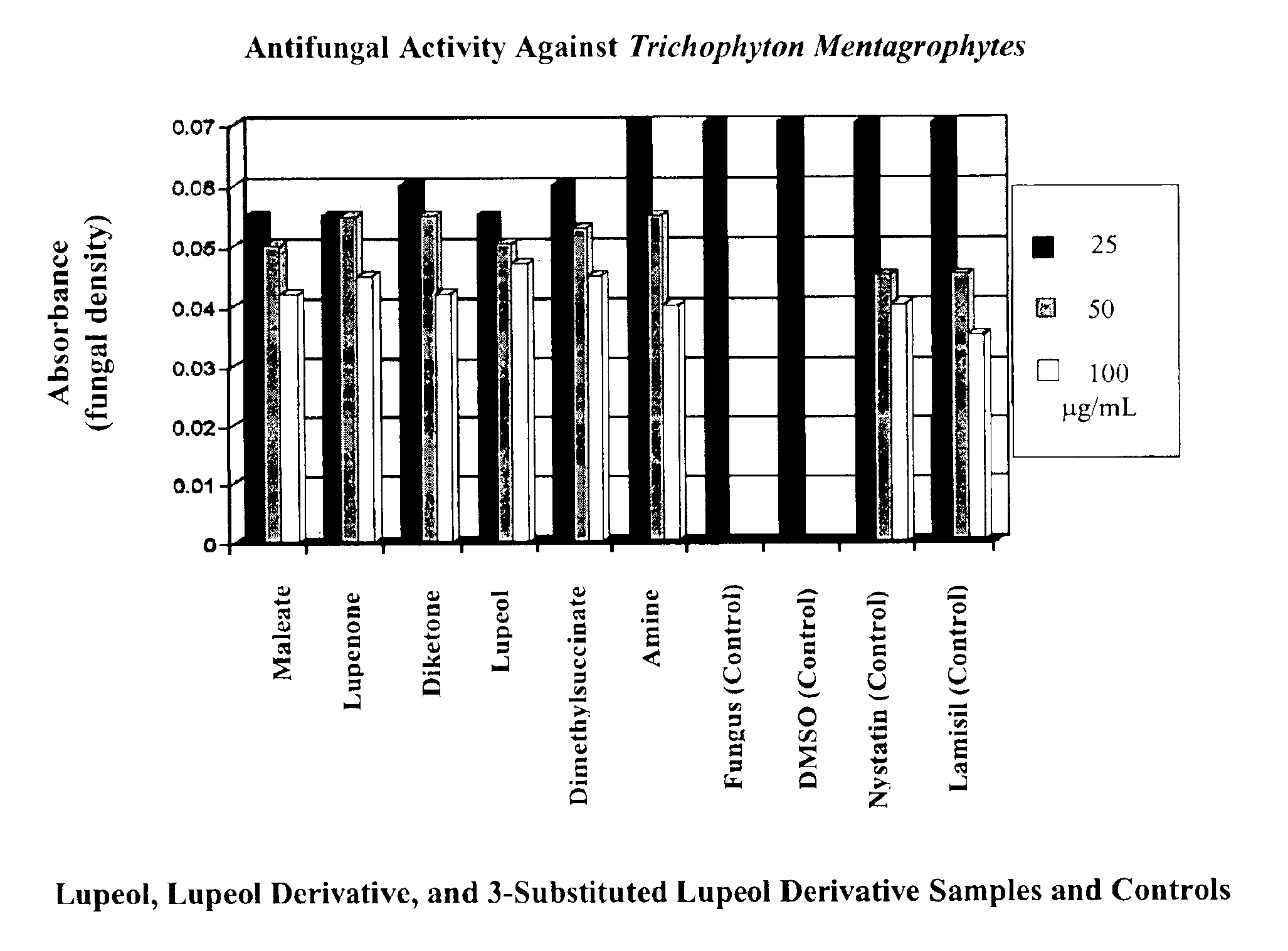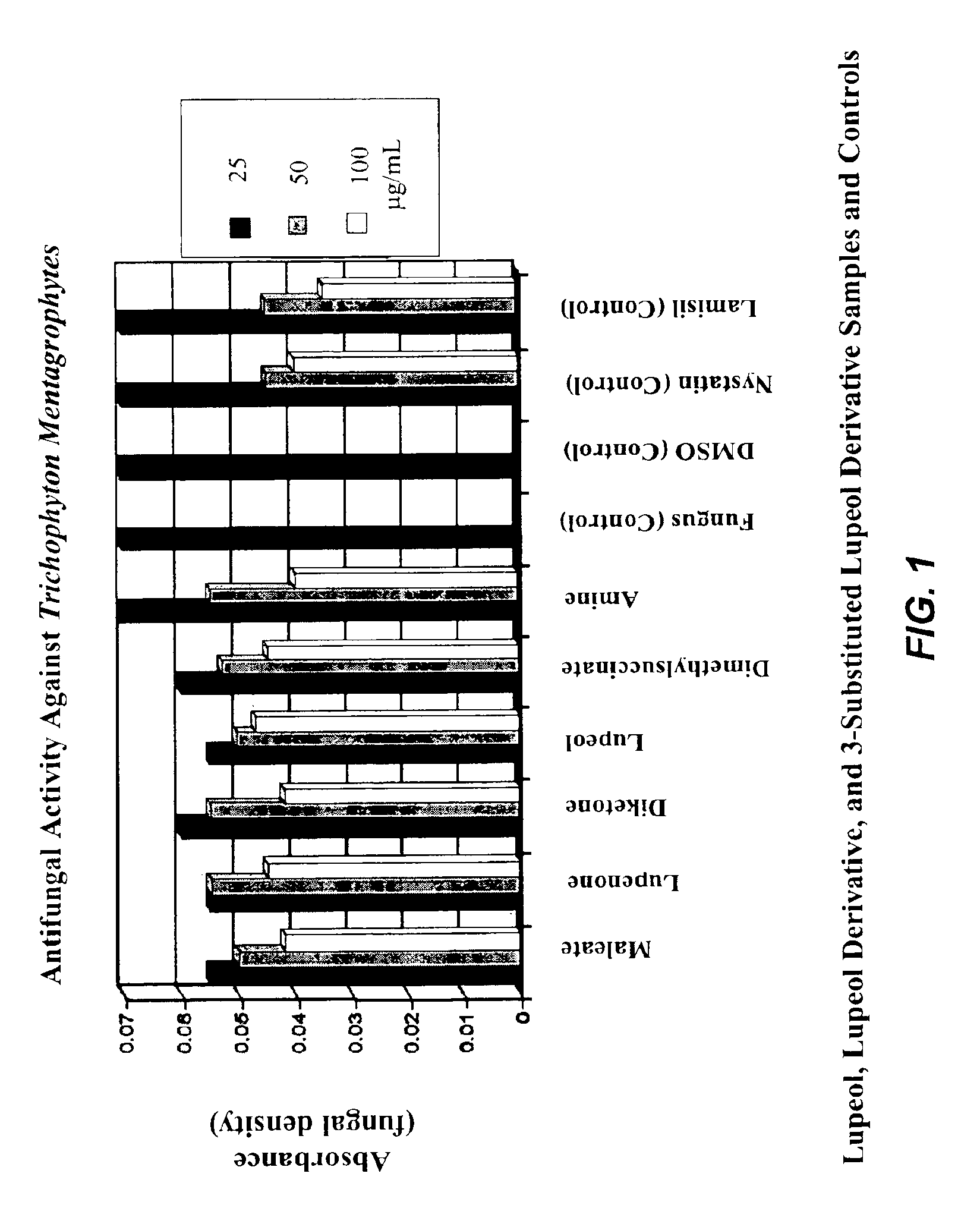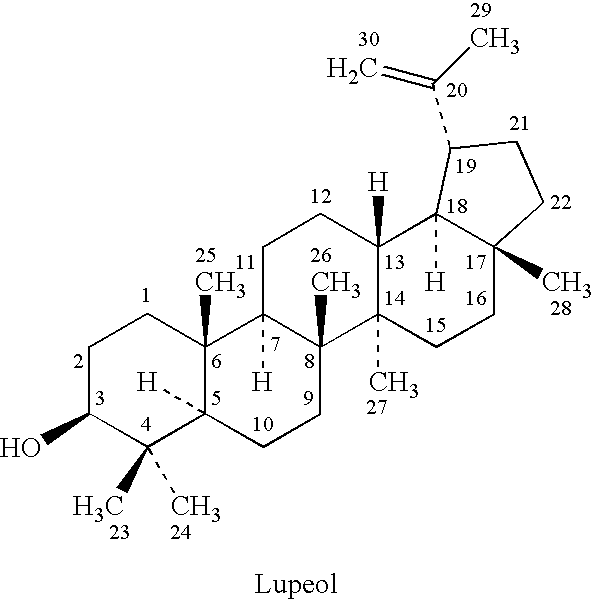Methods of treating fungal infections using lupeol
a technology of lupeol and fungal infections, applied in the direction of biocide, organic chemistry, drug compositions, etc., can solve the problems of difficult treatment of fungal infections, huge losses in agricultural productivity, human health problems, etc., and achieve the effect of enhancing skin appearan
- Summary
- Abstract
- Description
- Claims
- Application Information
AI Technical Summary
Benefits of technology
Problems solved by technology
Method used
Image
Examples
example 1
[0065]Lupeol, Monoglynol B, β-Viscol, Fagarasterol, lup-20(29)-ene-3β-ol
Isolation of Betulin.
[0066]Betulin was isolated from paper birch (B. papyrifera) bark. Shredded, dry bark (500 g) has been extracted with chloroform on a Soxhlet apparatus for 10 hours. The extract was evaporated and then was left overnight at 5-7° C. Crystals were filtered and washed with hexane and then dried in oven to give 94.5 g of crude Betulin. Double crystallization from chloroform and then mixture of chloroform-isopropyl alcohol (4:1) gives 64-68 g of pure Betulin mp. 258-259° C. [lit. mp 256-261° C.]. IR (KBr) 3378, 2942, 2868, 1645, 1453, 1374, 1106, 1031, 880 cm−1; 1H NMR (CDCl3) d 4.68 (S, 1H, 29-H), 4.58 (S, 1H, 29-H), 3.8 (D, J=10.3 Hz, 1H, 28-H, 3.34 (D, J=10.3 Hz, 1H, 28-H), 3.18 (DD, 1H, 3-H), 2.38 (M, 1H, 19-H), 1.68 (S, 3H, 30-Me), 0.76, 0.82, 0.97, 0.98, 1.02 (all S, 5×3H, 27-, 23-, 24-, 25-, 26-Me), 1.01-2.4 (complex CH—, CH2, 25H,); 13C NMR (CDCl3) d 151.249, 110.464, 79.736, 61.278, 56.0...
example 2
[0068]In this example, the antifungal properties of lupeol was determined by the direct addition method and the disk diffusion method.
[0069]Direct addition method. Sabouraud dextrose agar was prepared according to the manufacturer's instructions and 5.0 ml was dispensed in each 100×25 mm tube. The tubes were autoclaved. To each tube containing 5.0 ml of liquid agar at 45° C., 20 mg of solid test compound was added, to give a final concentration of 4 mg / ml. The agar was solidified in slants. The fungal cultures were then innoculated. The slants were incubated at 25-28° C. for 10-12 days, and the growth of the fungus was recorded every second day. The results in Table 2 indicate growth at the 12th day of inoculation.
[0070]Disk diffusion method. Sabouraud dextrose agar was prepared according to the manufacturer's directions, autoclaved, and solidified in sterile petri dishes. Yeast cultures were spread over the surface with a cotton swab. Filter paper disks of 10 mm diameter were each ...
example 3
[0076]In this example, derivatives of lupeol were tested for their activity in inhibiting the growth of Trichophyton mentagraphytes in liquid culture.
[0077]Direct addition to liquid culture method. Sabouraud dextrose broth was prepared according to the manufacturer's instructions, and 7.0 ml was dispensed into 100×25 mm tubes and autoclaved. To each tube containing 7.0 ml of liquid broth, the test compounds dissolved in DMSO were added to final concentrations of 25, 50, and 100 μg / ml. The tubes were then inoculated with 150 μl of a fungus suspension and incubated at 25-28° C. for 10-12 days. Growth was measured every second day by measuring optical density at 600 nm against a blank containing sterile broth.
Results.
[0078]The optical density of the cultures of Trichophyton mentagrophytes after 12 days of growth in broth with various concentrations of the test compounds is shown in FIG. 1. The full names of the compounds listed in the figure are as follows. “Maleate” refers to lupeol-3...
PUM
| Property | Measurement | Unit |
|---|---|---|
| concentration | aaaaa | aaaaa |
| concentration | aaaaa | aaaaa |
| concentration | aaaaa | aaaaa |
Abstract
Description
Claims
Application Information
 Login to View More
Login to View More - R&D Engineer
- R&D Manager
- IP Professional
- Industry Leading Data Capabilities
- Powerful AI technology
- Patent DNA Extraction
Browse by: Latest US Patents, China's latest patents, Technical Efficacy Thesaurus, Application Domain, Technology Topic, Popular Technical Reports.
© 2024 PatSnap. All rights reserved.Legal|Privacy policy|Modern Slavery Act Transparency Statement|Sitemap|About US| Contact US: help@patsnap.com










